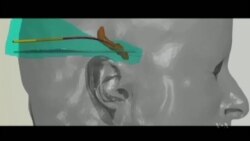U.S. researchers are developing a new type of robotic needle designed to remove blood clots in the brain. It hasn't yet been used in the operating room. But in simulated surgery, it's been able to remove 90 percent of the blood clots. The device could potentially save many lives.
Researchers at Vanderbilt University are using red and yellow gelatin molded to look like a brain. With the gelatin, they are testing a robot to see if it can suction out the red gelatin that represents a blood clot. The robot has a flexible needle that surgeons might use one day to remove real blood clots without damaging the surrounding brain tissue.
Robert Webster is an engineering professor with a personal interest in the robot's success.
"This was really compelling to me personally, because my father actually had one of these [blood clots] a couple of years ago, and at the time, there were no good treatments for him," he said.
Webster's father survived, but 40 percent of those who have this common medical problem, do not.
"Oftentimes based on the anatomy and the way the blood vessels are configured and these disease processes, the clots are oftentimes deep down in the brain," said Dr. Kyle Weaver, a neurosurgeon involved in this project. "And the thought is that surgery is actually going to do more damage than the blood clot is on its own."
That's where the robot may help. It has a series of thin, flexible metal tubes controlled by a computer. Webster says surgeons will be able to scan a patient's brain and the computer will then map the best route to the clot. The tubes will navigate around delicate brain matter, not through it.
The researchers are trying to design tools that could attach to the robot - such as a tiny grasper - that could break up a clot before suctioning it out. The robot has to go through trials and an approval process before it can be used in operating rooms. But the researchers hope that when it's ready, surgeons will be able to use it to save lives.
Researchers at Vanderbilt University are using red and yellow gelatin molded to look like a brain. With the gelatin, they are testing a robot to see if it can suction out the red gelatin that represents a blood clot. The robot has a flexible needle that surgeons might use one day to remove real blood clots without damaging the surrounding brain tissue.
Robert Webster is an engineering professor with a personal interest in the robot's success.
"This was really compelling to me personally, because my father actually had one of these [blood clots] a couple of years ago, and at the time, there were no good treatments for him," he said.
Webster's father survived, but 40 percent of those who have this common medical problem, do not.
"Oftentimes based on the anatomy and the way the blood vessels are configured and these disease processes, the clots are oftentimes deep down in the brain," said Dr. Kyle Weaver, a neurosurgeon involved in this project. "And the thought is that surgery is actually going to do more damage than the blood clot is on its own."
That's where the robot may help. It has a series of thin, flexible metal tubes controlled by a computer. Webster says surgeons will be able to scan a patient's brain and the computer will then map the best route to the clot. The tubes will navigate around delicate brain matter, not through it.
The researchers are trying to design tools that could attach to the robot - such as a tiny grasper - that could break up a clot before suctioning it out. The robot has to go through trials and an approval process before it can be used in operating rooms. But the researchers hope that when it's ready, surgeons will be able to use it to save lives.





